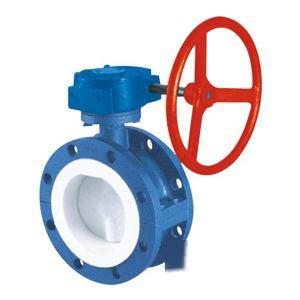PTFE-Lined Flanged Butterfly Valve has its butterfly plate installed in the diameter direction of the pipeline. In the cylindrical passage of the valve body, the disc-shaped butterfly plate rotates around the axis, with a rotation angle between 0°~90°. When rotated to 90°, the valve is in the fully open state.
Currently, the PTFE-Lined Butterfly Valve is widely used as a component for controlling the on-off and flow regulation in pipeline systems across many fields, including petroleum, chemical, metallurgy, hydropower, and more. In known butterfly valve technologies, the sealing method often employs a sealing structure with sealing materials such as polytetrafluoroethylene (PTFE). Due to structural limitations, it is not suitable for high-temperature, high-pressure, and wear-resistant applications. This type of valve is generally required to be installed horizontally in pipelines.
Main features of the PTFE-Lined Flanged Butterfly Valve include:
1. Compact and lightweight, easy to disassemble and maintain, and can be installed in any position.
2. Simple and compact structure with low operating torque, allowing for rapid 90° rotation to open.
3. Flow characteristics tend to be linear, with good regulation performance.
4. The connection between the butterfly plate and the valve stem uses a pinless structure, eliminating potential internal leakage points.
5. The outer circumference of the butterfly plate adopts a spherical shape, which improves sealing performance and extends the service life of the valve, maintaining leak-tightness after over 50,000 cycles of pressurized operation.
6. The sealing components are replaceable and provide reliable bidirectional sealing.
7. The butterfly plate can be coated according to user requirements, such as with nylon or PTFE.
8. The valve can be designed for flanged connections or wafer connections.
9. The driving method can be selected as manual, electric, or pneumatic.
Applicable temperature: ≤120℃ or ≤150℃,
Nominal pressure: ≤1.6MPa for water supply and drainage, wastewater, food, heating, gas, shipping, hydropower, metallurgy, energy systems, and light textiles, especially suitable for bidirectional sealing and situations where the valve body is prone to rust, used for regulating flow and shutting off media.













